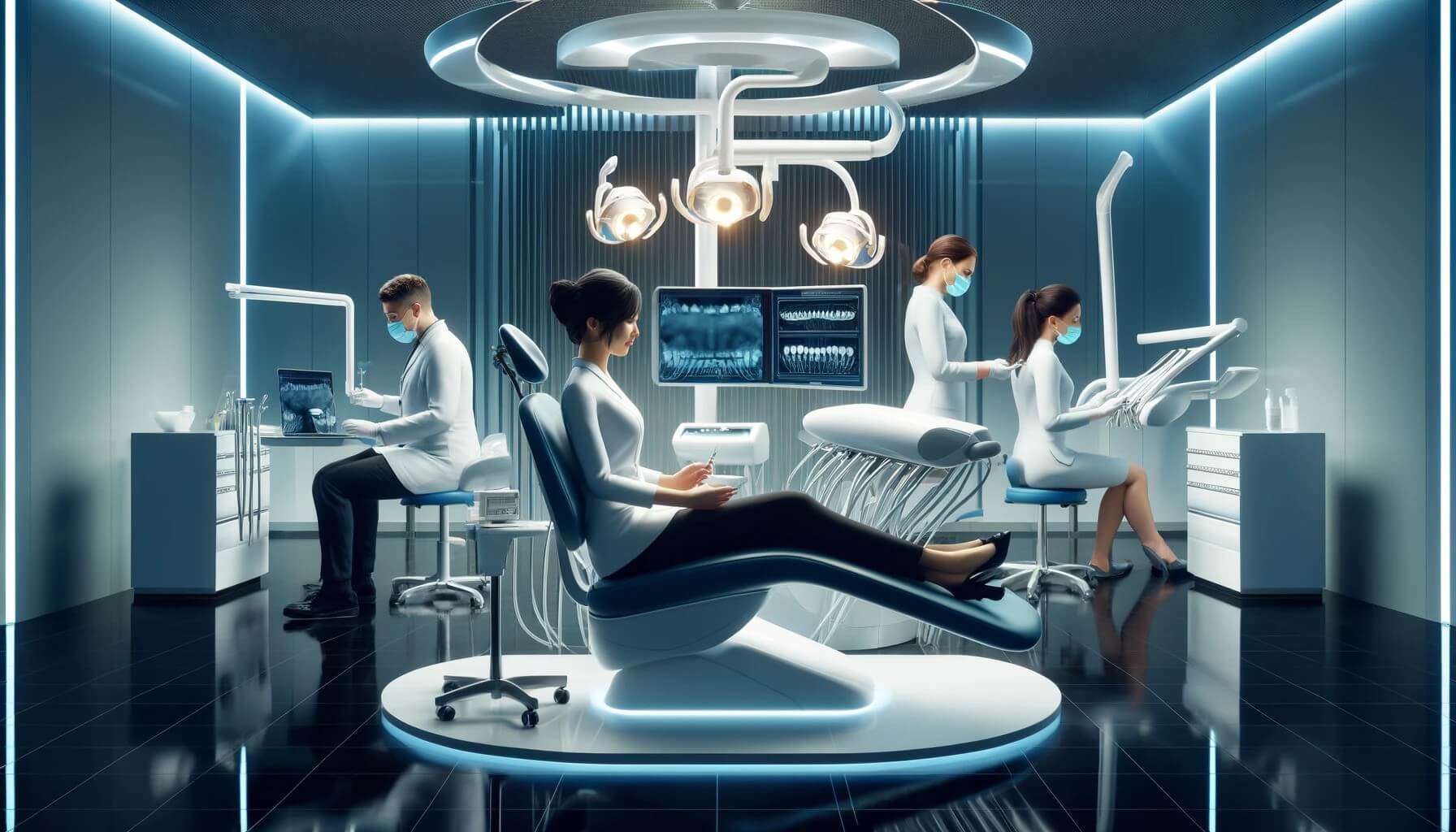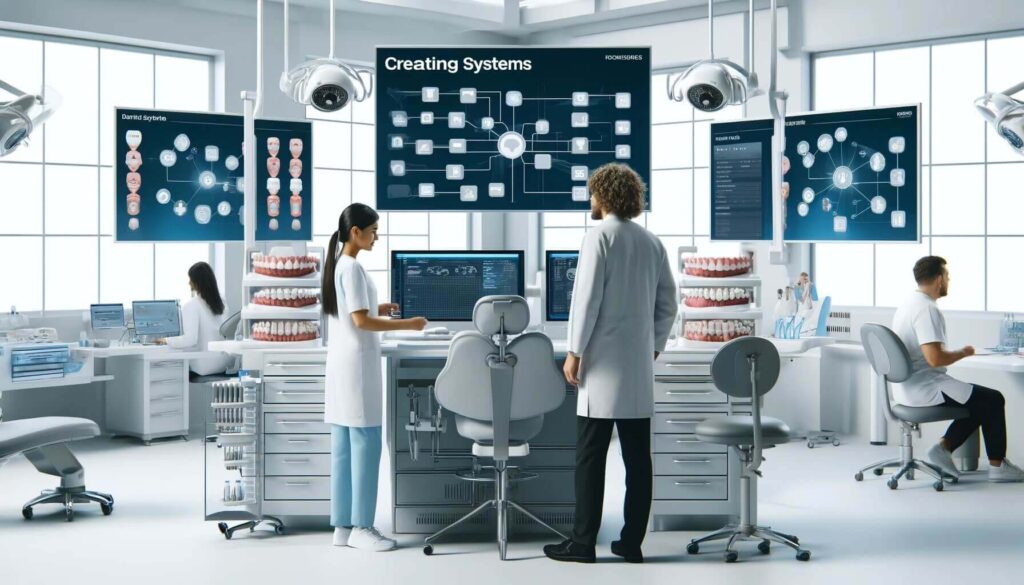Address
304 North Cardinal St.
Dorchester Center, MA 02124
Work Hours
Monday to Friday: 7AM - 7PM
Weekend: 10AM - 5PM

Transforming your dental practice into a thriving, efficient, and systemized powerhouse is not just a dream—it’s a reality waiting to be unlocked through the power of systems thinking. Discover how optimizing operations, boosting efficiency, and implementing strategic coaching and consulting can reclaim your freedom as a dental practice owner, leading you on a journey to unparalleled success.
Read on to uncover actionable insights and practical tips in this comprehensive guide, and take notes to start your journey towards a streamlined and prosperous dental practice today.

Imagine owning the perfect dental practice. What would that look like? If your vision aligns with many dental practice owners I’ve consulted, your ideal setup would likely include:
If this resonates with you, then you’re in for a treat. In this guide, I will walk you through the transformative steps to turn your current practice into the ideal one you just envisioned. Achieving this would be commendable on its own, but we will delve even deeper. The principles we explore here will not only revolutionize your practice but also enhance your personal life.
Grab your favorite drink, settle into a comfortable chair, and join me on this transformative journey that will redefine both your professional and personal trajectory.
As you progress through this guide, anticipate a profound shift in perspective—an “aha” moment that the Japanese term satori, a sudden awakening. You might find yourself making connections you hadn’t before, seeing the interplay between seemingly unrelated aspects of your practice and life.
This moment of clarity might make you realize that life, much like your dental practice, can be streamlined into efficient systems. Once you adopt this systems-oriented view, you’ll see solutions to challenges more clearly, approach problems with a more structured mindset, and begin to eliminate inefficiencies in both your personal and professional life.
Remember the allure of transforming your dental practice into the perfect business? That dream often contrasts starkly with reality for many dental practice owners. If you find yourself overwhelmed, underpaid, or constantly extinguishing fires, it’s likely due to a lack of effective systems.
The good news? This is fixable. Systems can replace the chaos with order, significantly reducing your daily stress and making your practice more efficient and profitable.
Consider this: even if you currently operate solo, how can you be sure your methods are optimal? Could there be a better way to manage appointments, patient records, or even your marketing efforts?
Introducing standardized, optimized systems into your practice ensures that every task is performed consistently and efficiently, which in turn frees up your time to focus on growth or even personal pursuits. This transformation from an owner-reliant to a systems-oriented practice will not only improve your operations but also enhance your role as a leader.
To solidify this concept, let’s think about your entire practice as a system composed of various subsystems—marketing, patient care, administration, etc. Your task is to ensure these subsystems work in harmony to achieve the overarching goal of providing excellent patient care and driving the practice’s success.
In the next sections, we’ll delve deeper into identifying these subsystems, understanding their functions, and learning how to optimize them to transform your dental practice into a model of efficiency and patient satisfaction. Stay tuned as we explore these transformative strategies in detail, paving the way for a thriving, system-driven practice.

Owning a dental practice can be as stressful as any other business, primarily due to what’s often called “death by a thousand cuts”: a never-ending sequence of inefficiencies, and dysfunctional or nonexistent systems, all leading to constant fire-fighting and perpetual distractions.
This cycle results in dealing with the same problems repeatedly, which not only saps your energy but also prevents you from achieving the independence of a true Rainmaker.
The key to escaping this cycle is to find permanent solutions to these recurring problems. As a dental practice owner aiming to be a Rainmaker, you must resolve these issues definitively using systems, not just slap on temporary fixes.
When faced with issues like patient dissatisfaction, late shipments (such as dental supplies), or untimely bill payments, the goal is to delve deeper into the superficial symptoms. Identify the root cause and implement a system to ensure these problems don’t recur.
This approach requires a shift from reactive problem-solving to proactive system creation. Think of it not as battling constant fires but as fireproofing your practice against such emergencies.
Let me share a story from my own experience that highlights the importance of this mindset. Several years ago, when looking to expand my practice, I hired two new employees. One of them, David, seemed competent but repeatedly failed to meet expectations, leading to his eventual dismissal. Initially, I thought of David as the problem—just an incompetent employee. However, adopting a systems-thinking perspective, I had to consider several critical questions:
This reflection revealed that David’s hiring and subsequent failure were not just about his capabilities but were indicative of deeper systemic issues within my business.
With a systems perspective, you begin to see business problems not as personal failures but as opportunities to improve underlying systems. This approach shifts the blame from individuals to processes, focusing on where the system broke down and how it can be fixed to prevent future issues.
To systematically address and resolve problems within your dental practice, follow these steps in what I call the Frustration Elimination Process:
Revisiting my earlier example with David, here’s how we applied the process:
By adopting this structured approach, you not only solve the immediate problem but also enhance your practice’s operational efficiency, reduce dependency on constant oversight, and ultimately pave the way for a more autonomous and successful dental practice.
This process, once mastered, can be applied to virtually any problem, transforming how you manage your practice and leading to substantial, lasting improvements.

Now that you’ve embraced the systems-perspective, you’re likely seeing each event in your life and business as the outcome of underlying systems.
Events aren’t isolated—they are the result of either well-designed systems or the lack thereof. With this insight, let’s dive into systemizing your dental practice to enhance efficiency, predictability, and your personal freedom.
The most daunting aspect of systemizing your dental practice is finding the time to start. It might seem overwhelming, but the commitment isn’t as intensive as it appears. By dedicating just one to three hours each week, you can start to see significant improvements.
This small investment of time can free up more hours in the long run, allowing you to focus more on patient care and less on administrative tasks.
Here’s a step-by-step guide to systemizing your dental practice:
Step #1 – Identify The Tasks To Systemize
Start by keeping a “Fix-It List” where you note down operational challenges as they arise. This list is crucial in a dynamic environment like a dental practice where issues can emerge frequently. Begin your systemizing efforts by addressing these problems using the Frustration Elimination Process discussed earlier.
Step #2 – Determine Who Will Create The Systems
If you’re running the practice solo, you’ll likely be creating these systems yourself. However, if you have a team, delegate system creation to the staff members who are most involved with the processes. This delegation not only enhances system relevance but also empowers your team to take ownership of their roles.
Step #3 – Record The Steps, Standards & Guidelines
Document the processes in a detailed, step-by-step format that anyone in your office can follow. This documentation should include:
Use tools like checklists, diagrams, and even video tutorials to ensure clarity and ease of understanding.
Step #4 – Test and Tweak The Systems
After documenting a system, test it thoroughly in your practice. First, have the system creator follow the procedures to ensure everything works as expected.
Then, have someone less familiar with the process attempt to use the new system to catch any overlooked details or steps.
Step #5 – Implement and Train
Once the system is refined and approved, implement it within your practice. Train all relevant staff members on the new procedures to ensure consistency and compliance. It’s essential that everyone understands and adheres to the new systems without deviation.
Step #6 – Monitor and Improve
Regularly review the implemented systems to ensure they are being followed and are delivering the desired outcomes. Make adjustments as necessary to keep improving efficiency and effectiveness.
Integrating systemization into your practice’s culture involves more than just creating and following procedures. It’s about building an understanding across your team that systems are there to make everyone’s job easier and more predictable. This cultural shift can reduce stress, improve patient care, and enhance the overall efficiency of your practice.
Systemizing your dental practice is the first major step in transitioning from being constantly involved in day-to-day operations to overseeing a self-sustaining business. As these systems take hold, your role will evolve from direct management to strategic oversight, allowing you more freedom to focus on growing your practice or enjoying life outside of work.
Remember, the goal of systemizing isn’t just to make your practice easier to manage—it’s to ensure that it continues to thrive, even when you’re not there. By establishing robust systems, you’re setting up your practice for success and ensuring a lasting legacy.

As you embark on creating systems for your dental practice, it’s essential to have a structured place to store them. This ensures that the efforts put into developing these systems don’t go to waste and that they are easy for your team to follow and utilize. A common issue is that systems are often not used because they are poorly organized or inaccessible.
To maximize the effectiveness of your systems, I recommend establishing three types of procedure manuals:
This manual contains all the systems and procedures for your entire dental practice. It’s primarily for you, the practice owner, and your management team. This is not meant for all staff members as it may be too extensive and contains sensitive information about the practice operations.
These manuals are tailored to individual roles within your practice. They document the tasks and activities that a person in a specific role is responsible for.
This makes it incredibly straightforward to train new staff and ensures that each team member knows exactly what is expected of them. Role-specific manuals facilitate accountability and efficiency.
Functional manuals describe processes that require coordination among multiple team members. These manuals are crucial for tasks that involve several steps and personnel, ensuring that everyone knows their role within the system.
For example, a functional manual might cover patient onboarding processes, detailing everything from scheduling to follow-up care.
Instead of creating a single, unwieldy manual, you should focus on developing role-specific and functional manuals. By doing so, you are effectively building a comprehensive manual that is broken down into manageable, relevant segments. Here’s how to start:
Creating detailed procedure manuals for your dental practice does more than just organize your operations; it transforms your role from an active manager to a strategic leader. With well-documented systems, your practice can operate efficiently even in your absence, giving you the freedom to focus on growth and innovation.
Embracing this structured approach to business management will ensure that your dental practice not only functions effectively on a day-to-day basis but also continuously evolves and improves. This is the foundation of a sustainable and successful practice that delivers high-quality patient care consistently.

Learn How to Maximize Patient Acquisition & Retention
“Success in dentistry isn’t just about mastering clinical skills; it’s about cultivating meaningful relationships with your patients, continuously enhancing their experience, and adapting to their evolving needs. Your practice thrives when your patients feel valued, understood, and cared for.”
Dr. Allen Leko D.D.S. — Dental Coach & Consultant
Learn How to Maximize Patient Acquisition & Retention
“Success in dentistry isn’t just about mastering clinical skills; it’s about cultivating meaningful relationships with your patients, continuously enhancing their experience, and adapting to their evolving needs. Your practice thrives when your patients feel valued, understood, and cared for.”
Dr. Allen Leko D.D.S. — Dental Coach & Consultant
